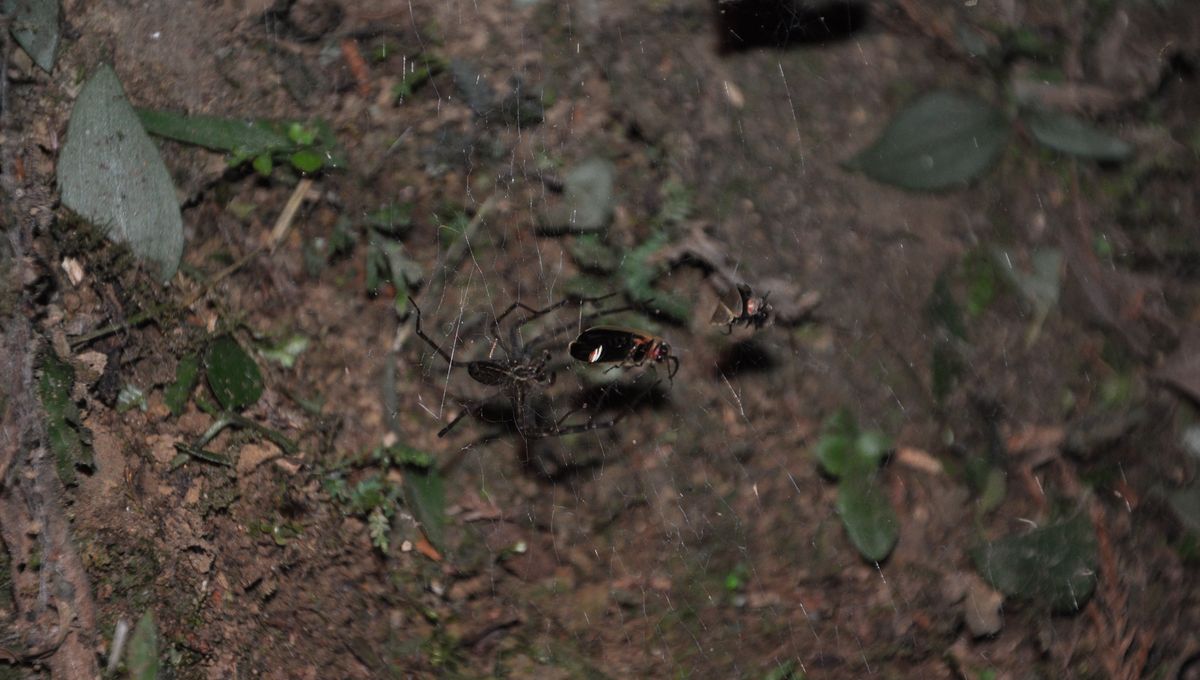
Nature doesn’t mess around when it comes to survival. One species of spider has come up with a hunting trick – using the bioluminescence of trapped fireflies as a living, glowing bait.
Males of the firefly species Diaphanes lampyroides can sometimes find themselves entangled in sheetweb spider (Psechrus clavis) webs. But instead of going quietly, the fireflies continue glowing for up to an hour. That’s where things get interesting. The sheetweb spiders don’t just eat male fireflies the moment they get caught. Nope, that’s too simple. Instead, the sneaky arachnids leave trapped fireflies to continue flashing their bioluminescent signal – like a neon advertisement attracting customers. And it works.
These nocturnal spiders build webs tucked away at the base of trees or nestled between rocks about 10 to 70 centimeters (4 to 27.5 inches) above the ground. Mature female fireflies (D. lampyroides) have small wings and generally do not fly, so they are rarely caught in the webs. The males, however, can fly, and once trapped in a web, they continue to emit a constant bioluminescent glow that attracts females.
In controlled field experiments, researchers in Taiwan placed male fireflies on spider webs and recorded their behavior for 90 minutes. It was observed that the trapped fireflies kept glowing at a fixed location, which resembled the pattern of a female firefly. The researchers suggested that the fireflies’ continuous glow might have been generated by their nervous system reacting with the spider’s venom or a stress response from being trapped in the web.
Additionally, to reduce the number of fireflies and spiders disturbed for science, further webs were fitted with LED lights mimicking firefly lights. From afar, these simulated signals likely looked suspiciously like a potential mate, and attracted up to ten times more males.
This means P. clavis might be engaging in what biologists call “sensory exploitation” – hijacking the communication signals of one species to benefit another.
“This study sheds new light on the ways that nocturnal sit-and-wait predators can rise to the challenges of attracting prey,” explained lead author Dr I-Min Tso in a statement.
Similar deceptions show up across the animal kingdom. For example, túngara frogs attract not only mates with their calls but also predatory bats, and blister beetle larvae trick solitary bees by mimicking the chemical scent of females.
So why don’t the spiders just eat the fireflies right away? Observations showed P. clavis doesn’t treat all prey the same – moths, for instance, are quickly consumed, but fireflies are often left glowing in the web. Researchers suspect it’s not a matter of taste (though some fireflies do contain chemical defenses). Instead, the spiders may be deliberately letting the glow work its magic as bait.
“Handling prey in different ways suggests that the spider can use some kind of cue to distinguish between the prey species they capture and determine an appropriate response. We speculate that it is probably the bioluminescent signals of the fireflies that are used to identify fireflies enabling spiders to adjust their prey handling behavior accordingly.”
There are potential downsides, though. A glowing web could draw predators toward the spider itself. But since most of those threats are daytime hunters, the nocturnal spider avoids the worst risks while reaping the rewards at night – especially during winter months when food is hard to find. The natural world is full of dirty tricks, but this one shines a little brighter than most.
The study is published in the Journal of Animal Ecology.
Source Link: Sneaky Spiders Can Turn Trapped Fireflies’ Glow Into A Handy Hunting Tool